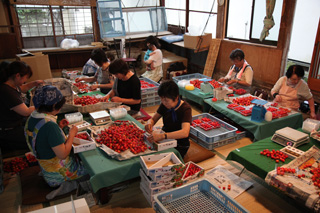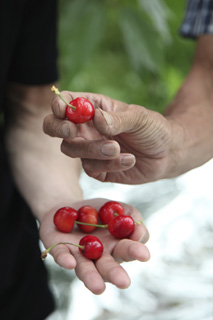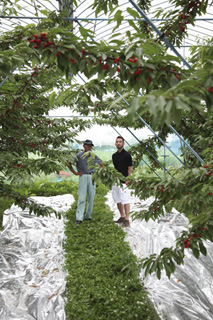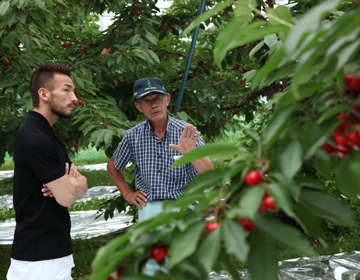 |
Sakuranbo cherries, fruit representing YamagataFor many, cherries are synonymous with Yamagata Prefecture. As it surpasses any other prefectures in cherry fruit harvest and shipping, and dominates the market with about 70% share, Yamagata Prefecture can be said to be the cherry fruit capital of Japan. And in that cherry fruit capital of Japan, there is a man who is known as the master of cherry fruit growing. We interviewed Kenichi Karube, the cherry fruit master. |
Benishuho, the real starThe most famous brand of cherries may be ”Satonishiki”, but at the time of the interview, the harvest for “Satonishiki” was over. The fruits on the trees were a breed known as “Benishuho”. It is larger than “Satonishiki” and has a higher sugar content. Karube picked a fruit from the tree and handed it to Nakata. A single bite was all it took for Nakata to change his expression. It was unbelievably sweet as a cherry. The sugar content on the Brix scale is about 25, which is equivalent to such fruits as peaches and melons. The texture of the thick flesh is also very good. Satonishiki has the fame but Benishuho has the taste. Said Karube. “It is sweeter, and less sour. Of course, it depends on the individual, but I personally think it’s more delicious than the Satonishiki. That’s why I think it’s a breed that is worth growing.” |
 |
 |
Pruning brings excitement”I am so surprised with how delicious these cherries are. What is the most important thing about growing cherries?” asked Nakata. “Exposure to sunshine” Karube replied. Unless you have plenty of sunlight shining on the fruits, you are not going to get much taste or good color. |
ACCESS
- Kenichi Karube, Karube Sakuranbo En
- Sagae, Yamagata Prefecture
- URL http://www6.plala.or.jp/karubesakurannbo/
 Discovering Japan [Nihon] through authentic craftsmanship [Honmono]
Discovering Japan [Nihon] through authentic craftsmanship [Honmono]